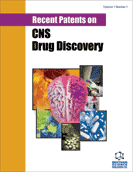Abstract
Gap junctions (GJs) are highly specialized membrane structures which allow the passage of small molecules and ions between neighboring cells. Intercellular communication via GJs is a crucial mechanism that plays a central role in several pathologies. This review focuses on: i) the role of connexins (Cxs, transmembrane proteins that form GJ channels) in the pathophysiology of neuronal injury after brain hypoxia-ischemia, ii) the opposing theories regarding whether Cxs are protective agents or contribute to the spread of damage, and iii) recent patent applications and registrations showing Cxs as key targets in regulating GJ-mediated intercellular communication.
Keywords: Gap junction, connexins, nervous system, neurons, injury, hypoxia, ischemia, knock out, knock down, blockers
Recent Patents on CNS Drug Discovery (Discontinued)
Title: Gap Junctions as Therapeutic Targets in Brain Injury Following Hypoxia- Ischemia
Volume: 3 Issue: 3
Author(s): Macarena Sahores and Ariadna Mendoza-Naranjo
Affiliation:
Keywords: Gap junction, connexins, nervous system, neurons, injury, hypoxia, ischemia, knock out, knock down, blockers
Abstract: Gap junctions (GJs) are highly specialized membrane structures which allow the passage of small molecules and ions between neighboring cells. Intercellular communication via GJs is a crucial mechanism that plays a central role in several pathologies. This review focuses on: i) the role of connexins (Cxs, transmembrane proteins that form GJ channels) in the pathophysiology of neuronal injury after brain hypoxia-ischemia, ii) the opposing theories regarding whether Cxs are protective agents or contribute to the spread of damage, and iii) recent patent applications and registrations showing Cxs as key targets in regulating GJ-mediated intercellular communication.
Export Options
About this article
Cite this article as:
Sahores Macarena and Mendoza-Naranjo Ariadna, Gap Junctions as Therapeutic Targets in Brain Injury Following Hypoxia- Ischemia, Recent Patents on CNS Drug Discovery (Discontinued) 2008; 3 (3) . https://dx.doi.org/10.2174/157488908786242452
| DOI https://dx.doi.org/10.2174/157488908786242452 |
Print ISSN 1574-8898 |
| Publisher Name Bentham Science Publisher |
Online ISSN 2212-3954 |
 3
3Related Articles
-
Group I Metabotropic Glutamate Receptors: Involvement in Drug-Seeking and Drug-Induced Plasticity
Current Molecular Pharmacology Herbal Medicine of the 21st Century: A Focus on the Chemistry, Pharmacokinetics and Toxicity of Five Widely Advocated Phytotherapies
Current Topics in Medicinal Chemistry New Insights into the Regulation of Liver Inflammation and Oxidative Stress
Mini-Reviews in Medicinal Chemistry Hypertension in the Elderly: An Evidence-based Review
Current Pharmaceutical Design Antipsychotic and Antiepileptic Drugs in Bipolar Disorder: The Importance of Therapeutic Drug Monitoring
Current Medicinal Chemistry A Perspective on Clinical Islet Transplantation: Past, Present and Developments for Future
Immunology, Endocrine & Metabolic Agents in Medicinal Chemistry (Discontinued) Calpain Inhibition: A Therapeutic Strategy Targeting Multiple Disease States
Current Pharmaceutical Design Preparation and Chemical Characterization of Eco-friendly ORMOSIL Nanoparticles of Potential Application in DNA Gene Therapy
Current Nanoscience Prevention and Repair of Circulatory Shock and Cerebral Ischemia/Injury by Various Agents in Experimental Heatstroke
Current Medicinal Chemistry Neurodegeneration and Neurogenesis: Focus on Alzheimers Disease
Current Alzheimer Research Purinergic Signaling and Hippocampal Long-Term Potentiation
Current Neuropharmacology Pharmacogenetics and Pharmacotherapy of Military Personnel Suffering from Post-traumatic Stress Disorder
Current Neuropharmacology In vivo Proton Magnetic Resonance Spectroscopy and its Applications in Autistic Disorder
Current Molecular Imaging (Discontinued) Assessing Activation States in Microglia
CNS & Neurological Disorders - Drug Targets Role of Mitochondrial Translocator Protein (18 kDa) on Mitochondrial- Related Cell Death Processes
Recent Patents on Endocrine, Metabolic & Immune Drug Discovery (Discontinued) A Review on Hematopoietic Stem Cell Treatment for Epilepsy
CNS & Neurological Disorders - Drug Targets Sirtuins: Possible Clinical Implications in Cardio and Cerebrovascular Diseases
Current Drug Targets Applications of Human Umbilical Cord Blood Cells in Central Nervous System Regeneration
Current Stem Cell Research & Therapy Application of Contemporary Neuroproteomic Techniques in Unravelling Neurological Disorders
Current Protein & Peptide Science Aflibercept (VEGF-TRAP): The Next Anti-VEGF Drug
Inflammation & Allergy - Drug Targets (Discontinued)






















